Insulation for the ceiling in a private house: types of materials used + how to choose the right one
Effective ceiling insulation provides high-quality insulation of the interior space of a private home and prevents the leakage of valuable heat from residential premises.Its presence has a beneficial effect on the general atmosphere in the rooms, makes it possible to save fuel and can significantly reduce utility bills.
You will learn everything about the reasons for performing thermal insulation, materials and methods of their installation from the article we presented. We will tell you how to choose the ideal insulation for you, what to consider when installing the system. Taking into account our recommendations, you can easily purchase the option that is suitable for your home.
The content of the article:
Reasons for ceiling insulation
Many owners of private property do not understand why they need insulation for the ceiling in their house, if during the construction process the attic space was equipped in accordance with the rules and requirements of modern heat conservation.
Among the most common are two significant reasons:
- combating condensation;
- reduction of energy costs.
Even with well-organized air exchange in the space between the floor ceiling and the roof in winter, moist and warm flows come into contact with the cooler ceiling surface, resulting in the inevitable formation of condensation.
It spoils the decorative design of the room, promotes the appearance of mold, and makes the surrounding air more damp and musty.

As for reducing energy costs, for this purpose, when creating an autonomous heating system in a private house, it is imperative to calculate the potential heat losses. In the process, it is possible to reveal that about 15% of all valuable heat generated by heating equipment escapes through the ceiling into the street.
Losses can be covered by increasing the capacity of the existing boiler room or installing additional heating devices, which always costs serious money. Only insulation installed on the ceiling in a private house will help solve the problem of condensation and heat loss immediately without huge financial costs.
You can use both traditional natural and more advanced artificial insulators, which are widely represented on the modern construction market.
Review of popular thermal insulators
For insulation of ceiling structures 5 groups of materials are suitable:
- bulk – dry sawdust/shavings, expanded clay, vermiculite, perlite;
- porous-fibrous – basalt (stone), mineral and glass wool;
- slab – dense sheets made of foamed polyethylene and polystyrene;
- self-leveling/sprayable – polyurethane foam, penoizol;
- cellulose – ecowool.
The first three options are installed using standard methods, while the fourth and fifth require professional equipment and specific skills. This is why self-leveling/spray insulation is much more expensive than insulating a house with other materials.
Group #1 - bulk materials
Bulk insulation is a secondary raw material and is a product of processing cellulose, glass, minerals and post-industrial materials.
The composition of some brands of heat insulators is enriched with additional elements: polystyrene beads, fragments of perlite and vermiculite. This improves the individual performance qualities of the materials and makes them more efficient.
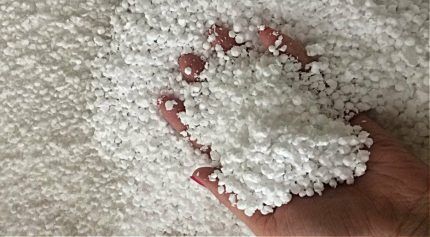
The main advantage of bulk elements is the absence of seams that contribute to heat leakage, as well as the ability to fill even the smallest voids and cracks. Main disadvantage ceiling insulation bulk materials - a tendency to shrink, characteristic of all insulation materials of this category.
They combat shrinkage by simply loosening the loose heat-insulating layer. Such systems require regular maintenance. To do this, use a regular rake, the impact of which also helps to dry the underlying layers.
Dry sawdust
Wood waste such as sawdust and shavings are a very old type of ceiling insulation. Minimum weight, complete environmental friendliness and low cost allow the material to maintain its popularity to this day. To enhance the working qualities, sawdust is mixed in a certain proportion with clay or other elements.
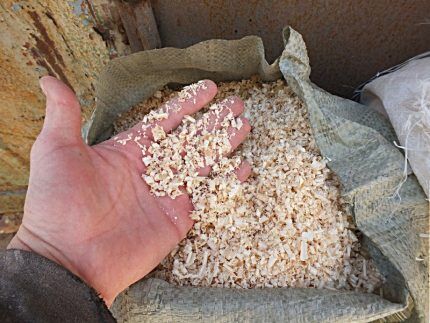
The result is an inexpensive and fireproof insulator that reliably protects the home from heat leakage. It does not rot during use and does not decompose over time. Not only a construction and installation professional can work with it, but also an ordinary home craftsman.
The disadvantage of this option is the ability to maintain a fire. In addition, sawdust is only suitable for thermal insulation of the ceiling of cold roofs. For attic insulation you need to choose a different material that is not afraid of moisture.
What is interesting about expanded clay?
Expanded clay is a lightweight building material with a porous structure. It is obtained by burning shale or clay. It is produced in the form of granules of different fractions with pores ranging in size from 3 to 45 millimeters. It belongs to the category of environmentally friendly materials and does not emit aggressive substances into the atmosphere.
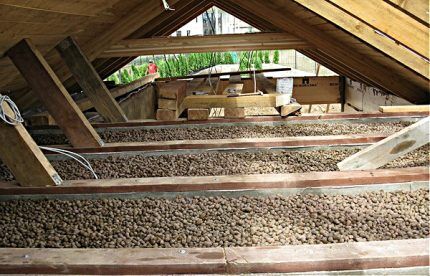
Among the main technological advantages of the material are the following:
- High thermal insulation properties. Heat loss in residential buildings is reduced by 80%.
- Relatively light weight. Expanded clay weighs 10 times less than concrete and does not exert a serious load on interior floors and foundations. A building insulated in this way does not feel additional fatigue even after a long time.
- Simplified installation. The work does not require expensive specific equipment. Masters do not have to have professional skills. The owner of the property can carry out insulation measures independently, without resorting to any outside help.
- Extended operational period. Provided that installation rules and principles are strictly followed, expanded clay insulation can last 100 years or more.
- Related Additional Features. Excellent sound insulation ability, ensuring natural convection, moisture absorption without loss of physical properties.
Thanks to these specific features, the material is widely popular and is most often used in private construction.
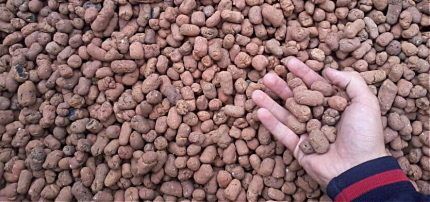
To insulate the ceilings of interfloor ceilings, a 10-20 mm fraction is used; for roofs, a 20-40 mm material is used.
Based on structure and shape, expanded clay is divided into three separate classes:
- Gravel – porous, round-type grain ranging in size from 5 to 40 mm.
- Sand – crushed residue of larger fractions with a texture size of no more than 5 mm.
- Crushed stone – angular particles of small size and arbitrary shape.
The grade of material is determined by its bulk density and varies from 250 to 800 units. The largest fraction of expanded clay is extremely rare in open sale. Usually it is produced only on an individual order and for specific purposes.
Overview of vermiculite characteristics
Vermiculite is a natural element of the silicate class from the hydromica group. Under the influence of high temperatures, it swells, increases several times and radically changes the crystal structure.
In industrial production it is produced in three size formats:
- small – up to 0.5 mm;
- average – 0.6-5 mm;
- large – 5-10 mm.
Demonstrates good bulk density and low thermal conductivity. Thanks to these specific qualities, it is widely used as a convenient household insulation material.
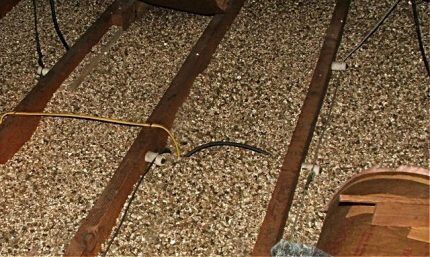
Vermiculite is highly durable, does not generate dust, does not crumble into smaller fractions during laying, and does not shrink during long-term use. It is chemically inert and does not react with aggressive chemical compounds and compounds used in private construction.
It is famous for its absorbent ability, easily absorbs large volumes of water and quickly releases moisture into the atmosphere, without losing its original physical qualities in the process.
Basic properties of perlite
Perlite is one of the new progressive bulk type heat insulators. Made from natural glass-like hard rock of volcanic origin. When heated to a certain temperature, it increases several times.
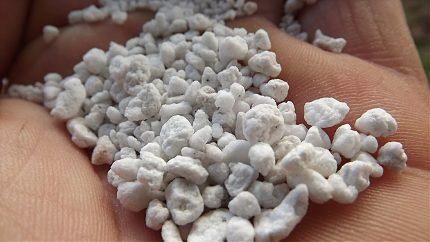
Perlite is not afraid of sudden temperature fluctuations, severe frosts and aggressive heat. The material does not burn, does not emit harmful substances and household allergens, serves for a long time and provides not only the preservation of heat in the room, but also high-quality sound insulation from external and internal noise.
Group #2 - porous fiber insulation
Fiber-porous material refers to artificial inorganic insulation.The group includes slag wool, stone wool and glass wool. These materials are actively used not only in the arrangement of the ceiling, but also in the construction floor insulation and walls of buildings of different heights.
The production of all types follows the same principle. The original raw material melts at high temperature. Then fibers are drawn from the fire-liquid mixture using various technological methods. They are intertwined with each other in a certain order to obtain a single covering material.
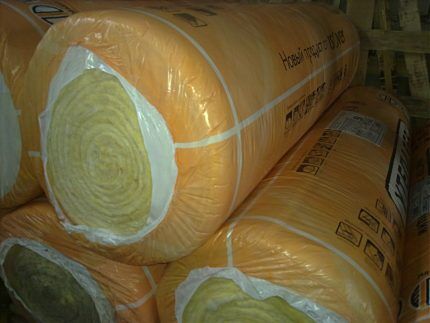
Using a phenol-formaldehyde resin binder, the fibers are combined and placed in a polymerization chamber. A final heat treatment gives the material its final shape.
Porous fiber insulation for ceilings is available in two forms:
- medium density rolls/mats;
- pressed boards with excellent strength characteristics.
The first option is excellent for thermal insulation of ceilings, floors and other structures that do not experience serious operational loads. The second can be placed in places subject to severe mechanical pressure.
The main disadvantage of insulators of this type is the release of substances into the air that are harmful to the human body. That is why materials are not recommended for indoor insulation.
Glass wool for insulation
Glass wool weighs little and is inexpensive. Most often used to insulate ceiling structures from the attic space. Demonstrates low thermal conductivity and copes well with vibration loads.
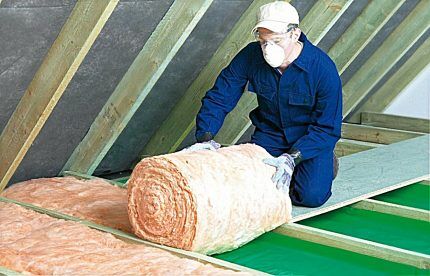
In domestic conditions, glass wool does not burn. Melting begins in critical cases when the temperature reaches 250 degrees. When compressed, it decreases in volume by 5-6 times. It has weak structural strength. It is attached to the surface with a special glue.
Stone (basalt) wool
Stone wool is made from gabbro-basalt rocks. It has low thermal conductivity and exhibits good resistance to vibration and mechanical stress. Does not burn and almost does not absorb water.

Basalt wool easily withstands temperature loads of 600-700 °C. With well-organized ventilation, it dries quickly, does not rot or crumble over time. Basalt and glass wool has a general name - mineral. This same concept, according to GOST 31913-2011, also includes the slag variety.
Let's look at the main reasons for the popularity of mineral wool among the population. The fact is that it demonstrates minimal thermal conductivity regardless of the surrounding climatic conditions. Does not require additional insulation during installation.
It allows steam to pass through well and does not retain moisture. Maintains normal air circulation and makes it possible to create the most pleasant microclimate in the room.
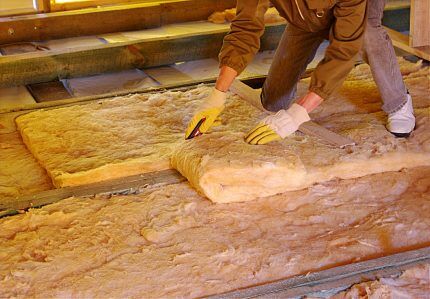
Classic mineral wool almost does not shrink and does not deform throughout the entire operational period.
Slag stone is not used in residential buildings due to the release of volatile toxins, so we did not provide its technical characteristics.
Group #3 - slabs for ceiling insulation
Plates for ceiling insulation are made from modern polymer compounds.
Finished products practically do not allow moisture to pass through, have good strength and keep their shape normally throughout the entire operational period. They weigh little and are conveniently mounted on any type of ceiling structure.

Foam boards are the most popular on the market. extruded polystyrene foam and foamed polyethylene. They do not emit harmful odors, are durable and retain their physical characteristics for many years.
Group #4 - self-leveling/sprayed heat insulators
Polyurethane foam and penoizol are among the most progressive heat insulators. They effectively retain maximum heat in the room and save energy resources. They are laid using automatic blowing installations with corrugated hoses and special nozzles.
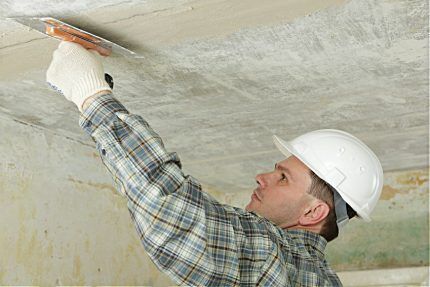
Unlike roll materials, sprayed materials do not cake and do not lose their original shape. Due to their original liquid consistency, they do not require adjustment to specific sizes and dimensions.
Suitable for installation on any type of ceiling structure, from strong concrete to lightweight adobe and wood. Provide high durability of the coating and create impeccable sound insulation.
Group #5 - insulation using ecowool
Ecowool is a modern, lightweight and safe insulation for ceiling structures. Consists of small cellulose fibers.
Mounted in two ways:
- dry;
- wet.
When dry laying, the material simply crumbles between the floor beams and is carefully compacted. Pre-laying of the film is not required, since ecowool is a natural absorbent.

Wet application requires special equipment. It mixes cellulose fibers with a special glue and applies them under pressure to the surface of the floors. The resulting monolith does not support combustion, and mold spores and bacteria do not multiply inside it.
What should the ideal material be?
To insulate the ceilings of private households, the construction market offers a variety of materials. They are subject to certain requirements that must be met.
Important characteristics of a heat insulator
Among the main ones are the following positions:
- extremely low thermal conductivity;
- high moisture resistance;
- minimal flammability or its complete absence;
- environmental Safety;
- good compressive strength;
- flexibility and ability to restore shape;
- resistance to mechanical damage.
Artificial and natural insulators with such indicators are suitable for use with both wooden and reinforced concrete floors and ceilings.
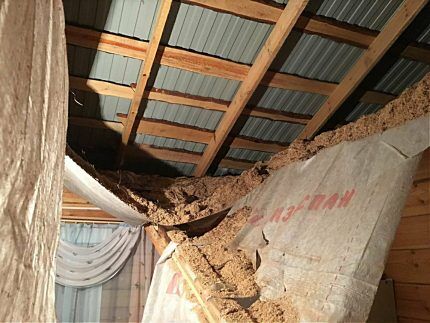
Proposed type of insulation
The choice of a specific type of material depends on many additional parameters and the budget allocated for insulation work in the household. And also on the type of insulation and the chosen noise insulation schemes. Let's talk about the latter in more detail next.
Measures for additional insulation of the ceiling in a private household include two types of work:
- external;
- internal.
Both options are equally effective and each owner can choose the most convenient method of home energy protection. The difference lies in the materials used and technological installation features. For wooden floors, especially in old houses, you need to choose low-weight, non-combustible materials.
Such insulation will not create additional load on the supporting structures and will fully comply with current fire safety rules, which should not be neglected under any circumstances.
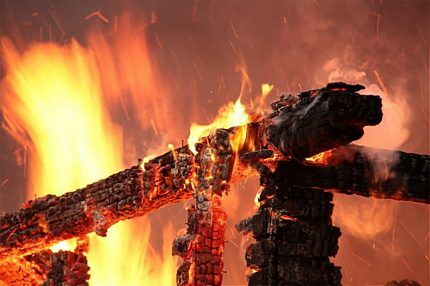
For low or standard ceilings, it is most reasonable to do external insulation - through the attic or attic) Any lightweight insulators are suitable for this. Internal insulation “eat up” the usable space of the room and lower the ceiling by at least 15-20 centimeters.
Glass wool and its derivatives are not desirable for internal insulation. Under certain conditions, these materials release substances harmful to humans into the air.
Such insulation can only be used under the condition of mandatory insulation from the living space using plastic film or drywall.
He will familiarize you with the rules for selecting thermal insulation and the technology of floor insulation using joists. next article, which we strongly recommend reading.
Conclusions and useful video on the topic
The result of thermal insulation work on the upper floor in a private house:
How to properly insulate a ceiling in a private home and avoid fatal mistakes:
How to organize heat and sound insulation in your home + tips for choosing materials:
When choosing how to insulate the ceiling in a private home, you need to carefully study the physical characteristics of the materials on the market and compare these data with the available budget.
Laying bulk, roll and tile materials will cost less than creating self-leveling/sprayed insulation, but will provide an equally high-quality effect. Heat loss will be reduced by at least 15%, and the microclimate in the house will become more pleasant, comfortable and cozy.
Tell us about how you selected thermal insulation material for arranging the ceiling in your country house or country house. Which option did you prefer and why? Please write comments in the block below, ask questions, and share useful information on the topic of the article.




To insulate the ceilings, I personally used Knauf Insulation mineral wool. According to reviews and the opinion of the store seller, the material is one of the best because it is environmentally friendly, fireproof, greatly reduces heat loss, and does not interfere with the natural removal of steam and air circulation. About three years ago, during a major renovation, I insulated both the house and the rafter system when converting the flooring. The effect is pleasing.
I finally decided to use glass wool to insulate the ceiling. It weighs little, and its thermal conductivity is quite low. For example, based on experience and the recommendations of the builders, I put foam plastic on top and laid a water barrier. There is an effect, from above I see how warm air is retained from the glass wool, and the ceiling seems to breathe, but at the same time the insulation is dry. From a safety point of view, glass wool does not burn, but only melts at high temperatures.